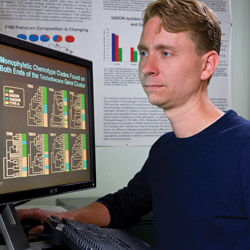Using Genetics to Uncover Food Pathogens

Although the United States has one of the safest food supplies in the world, food safety remains an important issue for the American consumer, the food industry, and federal regulatory and public health agencies.
Nearly everyone has had direct experience with food-borne illness, and regional or nationwide recalls of contaminated food are frequently in the news. The federal government estimates that more than 70 million people experience a food-borne illness each year in the United States. While most of these illnesses are relatively minor, they can be very dangerous for people in vulnerable populations, and roughly 5,000 people die each year due to food-borne disease. In addition, a recent report found food-borne illness in the U.S. results in $152 billion in annual costs associated with healthcare and lost productivity. Significant additional costs result from the massive recalls of food following outbreaks of illness or the detection of some potentially harmful contaminate in a food product.
Scientists at the USDA-ARS National Center for Agricultural Utilization Research (NCAUR) in Peoria are developing new approaches to improve food safety by studying the genes of bacteria commonly known as salmonella and listeria, two of the leading culprits behind food recalls and food-borne disease in the U.S. Salmonella is the most common cause of food-borne illness and death, and was recently responsible for recalls of foods ranging from meat and poultry products to peanut butter and a commonly used food additive found in a wide range of processed foods.
Listeria causes very severe illness and is the second leading cause of food-borne disease-related deaths; more than 30 percent of infected people end up in the hospital. Although it is much less common than salmonella, listeria is a major cause of food recalls because the federal government has a zero-tolerance policy due to the serious nature of illnesses caused by this pathogen. Controlling these harmful bacteria is difficult and requires new information and technologies to improve the efficiency and effectiveness of food inspection and public health programs.
Working in collaboration with partners at the USDA’s Food Safety and Inspection Service and the Centers for Disease Control and Prevention, ARS scientists at NCAUR have identified genetic differences that allow them to distinguish individual strains of food-borne bacteria and identify the bacteria that pose the greatest risk to human health.
NCAUR scientists used this genetic information to develop several new technologies for use in the fight against food-borne disease. These include a new DNA test to help public health agencies quickly identify food-borne disease outbreaks and determine the source of the contaminated food, which is critical to reducing the number of people that will become ill and the amount of food that will ultimately need to be recalled.
A second approach to controlling food-borne disease has been to integrate new discoveries about the biology of these bacteria into new DNA technologies that allow food inspectors and food processors to more effectively focus their resources toward food products and sources of contamination that pose the greatest risk to public health. Additional research promises to further improve our understanding of these harmful bacteria and will lead to new technologies, novel disease control strategies, and more effective regulatory policies that provide maximum protection to consumers while limiting the number and size of food recalls. iBi
Todd Ward, Ph.D., is a research geneticist for the Bacterial Food-borne
Pathogens and Mycology unit at the USDA ARS National Center for
Agricultural Utilization Research in Peoria.

